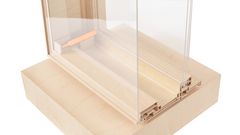In cooperation with the renowned façade company FRENER & REIFER, the Associate Professorship of Architectural Design and Building Envelope has developed a self-regulating building envelope as a responsive skin opening and closing itself auto reactively. Triggered by temperature and without additional energy, this double skin façade breathes like our human skin that opens its pores to regulate body temperature. In this sense, this building skin reacts decentralized and avoids the use of mechanical ventilation and air conditioning of interior spaces - or at least to significantly reduces them.
Please follow this link to see the movie:
https://vimeo.com/232342315?utm_source=email&utm_medium=vimeo-cliptranscode-201504&utm_campaign=29220
responsive architecture
We strongly believe that alike flora and fauna buildings need to respond dynamically to the dynamic changes in their environment. The ability to change according temperature, light and humidity conditions is important for all creature in order to ensure best condition for its life. The increase of the level of adaptivity improves the performance of life. All the same, adaptive building systems are becoming increasingly relevant in the context of an efficient use of energy. As is shown by the simple fact that the building sector at present accounts for a substantial, 44-percent share of the world’s consumption of primary energy. Architects and engineers are therefore increasingly squaring up to this state of affairs – whereby the proposed solutions differ greatly. Adaptive architecture is one approach taken; it’s an architecture that constantly updates itself. It adapts, largely independently, to changing climatic conditions, be it the transition from day to night or from one season to another. And it responds, similarly to nature, dynamically and mutably. Thanks to adaptive architecture, not only do technical aspects change, such as the buildings’ performance characteristics, but how we consider architecture in aesthetic and cultural terms is also important. The term “adaptive” addresses the ability of a high performing building envelope to respond to changing exterior situation by material inherent behaviour in order to control the energy flows and provide maximum of user comfort.
Credits:
Dr. Philipp Lionel Molter
Associate Professorship of Architectural Design and Building Envelope
TUM Department of Architecture
Technical University of Munich
Team: Claudio Aresta, Johannes Ingrisch, Tillmann Klein
In cooperation with: Frener Reifer Fassaden, Michael Reifer
